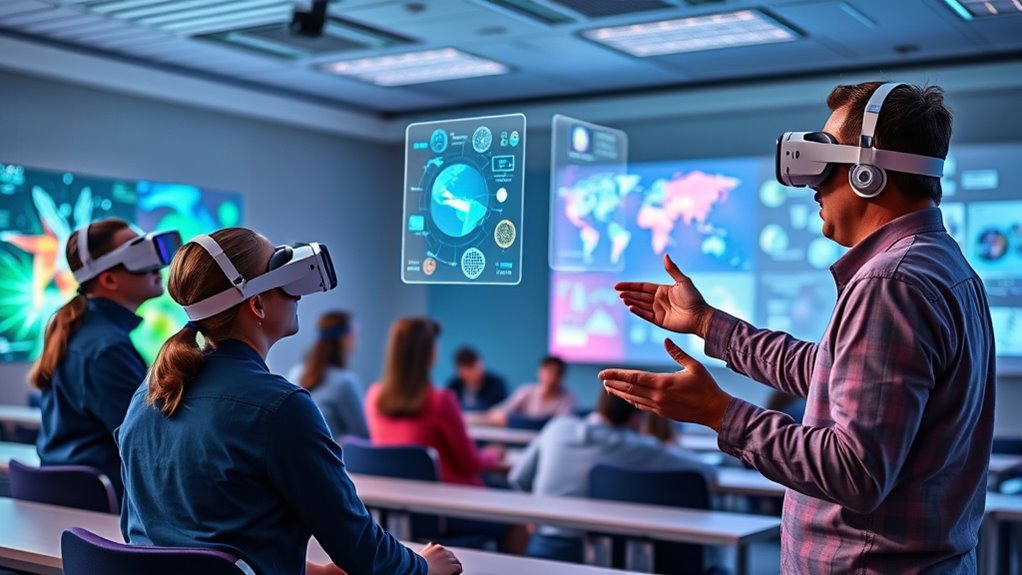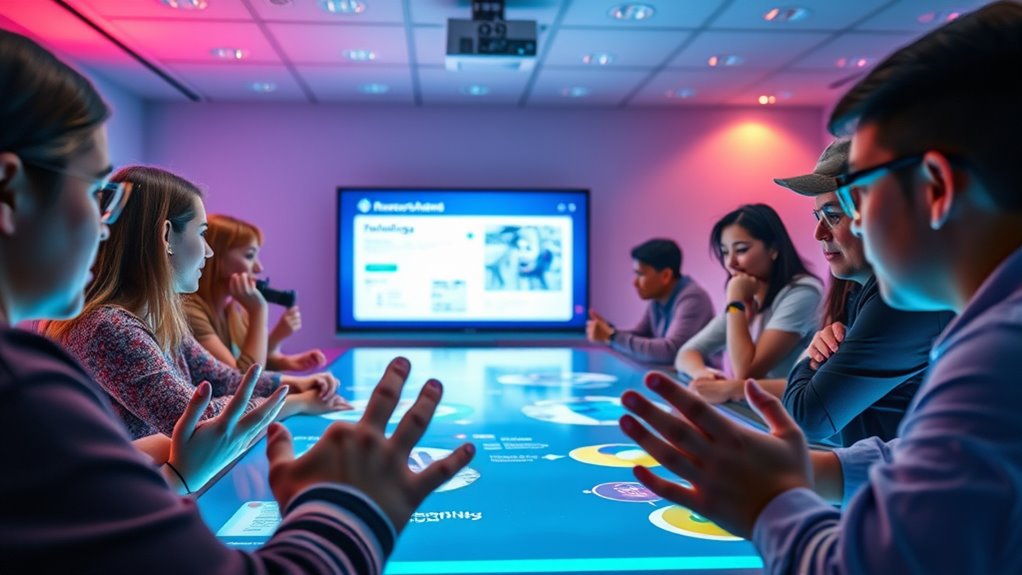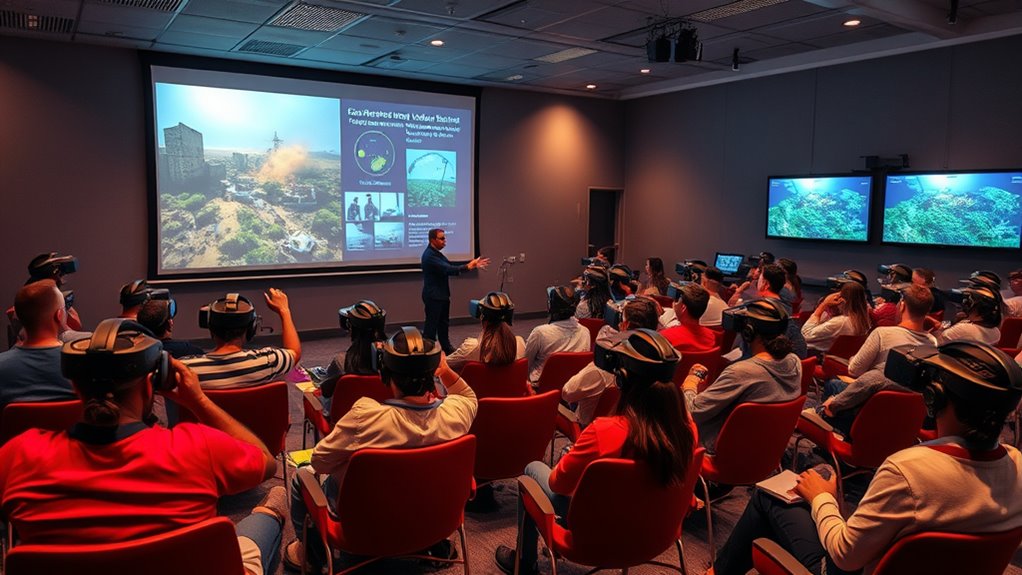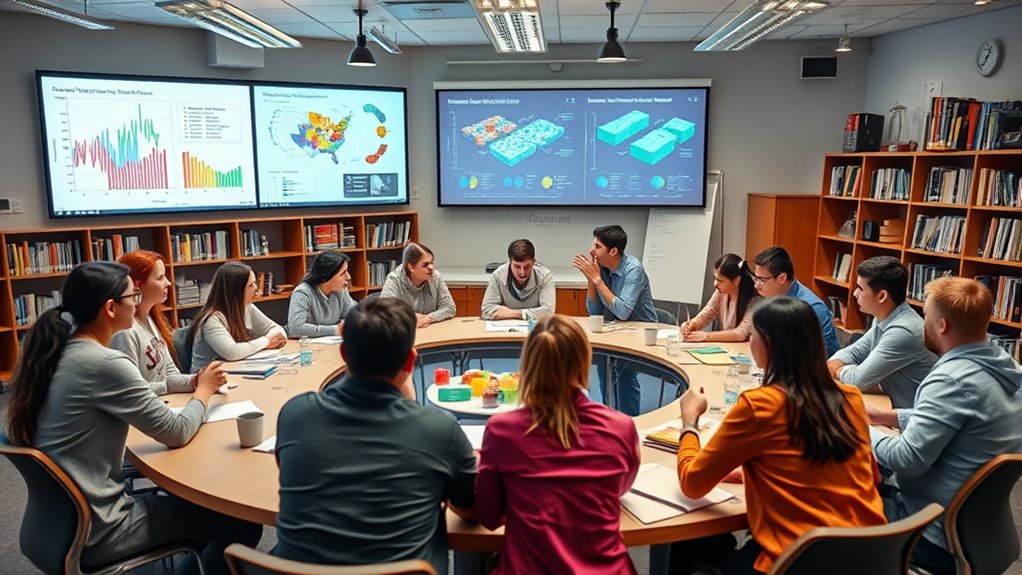Immersive debriefs turn research insights into engaging, hands-on experiences that deepen your understanding and boost retention. You can use virtual reality, simulations, and interactive data visualizations to make lessons more relevant and exciting. By designing scenarios that mirror real challenges and encouraging reflection, you’ll foster critical thinking and confidence. Keep exploring these techniques to unveil the full potential of experiential learning and discover how immersive debriefs can transform your approach.
Key Takeaways
- Use scenario design that mimics real-world challenges to make research findings relevant in immersive debriefs.
- Incorporate interactive visuals and data storytelling to help learners understand complex research insights.
- Implement diverse feedback methods, such as immediate critiques and participant experimentation, to deepen understanding.
- Employ immersive technologies like VR and simulations to visualize data trends and enhance experiential learning.
- Foster dialogue and reflective analysis during debriefs to reinforce research findings and promote practical application.
The Rise of Immersive Learning in Education

Immersive learning has gained significant momentum in education as technology continues to evolve. Virtual reality immerses you in realistic environments, making lessons more engaging and memorable. With VR, you can explore ancient civilizations or conduct complex science experiments without leaving your classroom. Gamification also plays an essential role by turning learning into interactive challenges and rewards, increasing motivation and participation. These tools encourage active involvement, helping you retain information better than traditional methods. As technology becomes more accessible, schools are increasingly adopting immersive learning strategies to enhance student experiences. You’re no longer limited to textbooks; instead, you can plunge into virtual worlds that make learning both fun and effective. Incorporating high-resolution projectors into classrooms can further elevate the immersive experience by providing vivid and detailed visuals, making lessons even more captivating. This shift promises a future where education is more dynamic, engaging, and tailored to individual needs.
Transforming Data Into Engaging Experiences

When data is transformed into interactive and visually compelling formats, it becomes much easier to understand and retain complex information. Virtual reality offers immersive environments where data can be presented as engaging narratives, making abstract concepts concrete. By integrating storytelling techniques, you turn raw data into relatable stories that resonate emotionally, enhancing engagement. This approach helps learners connect with the material on a deeper level, fostering better retention. Using virtual reality, you can create simulations that visualize data trends or scenarios, making insights tangible. Incorporating data visualization techniques can further clarify complex information and highlight key insights. Combining these methods ensures that data isn’t just numbers but becomes an experience—dynamic, memorable, and impactful. Transforming data this way revolutionizes how learners process and apply research findings, making education more interactive and meaningful.
Techniques for Designing Effective Immersive Debriefs

Designing effective immersive debriefs requires a clear focus on creating engaging, interactive experiences that facilitate reflection and learning. Start with scenario design that closely mirrors real-world challenges, encouraging participants to actively problem-solve and apply their knowledge. Use diverse feedback techniques, such as immediate, specific critiques or reflective questioning, to deepen understanding and guide improvement. Incorporate opportunities for participants to experiment within the scenario, then provide constructive feedback that highlights strengths and areas for growth. Remember, effective debriefs aren’t just about presenting information—they’re about fostering dialogue, encouraging self-assessment, and reinforcing key concepts. By thoughtfully designing scenarios and employing targeted feedback techniques, you create immersive experiences that maximize learning outcomes and engagement. Including elements like aquatic exercise and other water-based activities can also enhance physical engagement and retention during debriefs.
Benefits of Experiential Approaches for Learners

Experiential approaches offer learners the opportunity to engage directly with real-world scenarios, making learning more relevant and impactful. By immersing yourself in authentic experiences, you develop a deeper understanding and retention of concepts. These methods promote mindful reflection, allowing you to analyze your actions and thought processes critically, which reinforces learning. Emotional engagement also plays a crucial role, as connecting emotionally with the material enhances motivation and empathy. When you actively participate in immersive debriefs, you’re more likely to internalize lessons and apply them confidently in real situations. Additionally, understanding the vibrational nature of reality as emphasized by Abraham Hicks can deepen your experiential learning by aligning your energy with your desired outcomes. This combination of reflection and emotional involvement accelerates skill development and encourages a growth mindset, ultimately leading to more meaningful and lasting learning outcomes.
Real-World Examples of Immersive Debrief Success

Real-world examples demonstrate how immersive debriefs lead to tangible improvements across various fields. In emergency response training, scenario analysis through immersive simulations helps responders identify weaknesses and improve decision-making. By actively engaging in realistic scenarios, they develop cognitive mapping skills, enabling quicker, more accurate reactions in real crises. Similarly, in healthcare, immersive debriefs using scenario analysis allow medical teams to dissect complex procedures, fostering deeper understanding and collaboration. Participants build cognitive maps of workflows, reducing errors and enhancing patient safety. In the corporate world, immersive debriefs after simulations enable teams to analyze decisions and refine strategies. These examples show that by integrating scenario analysis and cognitive mapping into immersive debriefs, learners gain practical insights that translate into improved performance and better outcomes.
Frequently Asked Questions
How Can Educators Assess the Effectiveness of Immersive Debriefs?
You can assess the effectiveness of immersive debriefs by observing learner engagement during the sessions and gathering feedback through strategic feedback strategies. Ask participants about their experiences, insights, and challenges to gauge understanding. Use surveys, reflection journals, or real-time polls to collect data. Analyzing this feedback helps you identify areas for improvement and confirm whether learners are applying new knowledge effectively. Engagement and feedback are key indicators of success.
What Are the Cost Considerations for Implementing Immersive Learning Experiences?
Imagine your budget as a garden, where careful planning and resource allocation determine which plants — or experiences — flourish. When implementing immersive learning, you’ll need to contemplate costs like technology, space, and training. Budget planning helps you balance expenses, ensuring you invest wisely without overextending. By strategically allocating resources, you create a vibrant environment where immersive experiences thrive, enriching learning without draining your financial soil.
How Do Cultural Differences Influence Immersive Debrief Design?
When designing immersive debriefs, you should consider how cultural differences impact cross-cultural communication and cultural sensitivity. You’ll need to adapt scenarios to respect diverse perspectives and communication styles, guaranteeing inclusivity. By incorporating cultural awareness, you create a safe space for participants to share openly. This approach enhances engagement, promotes understanding, and ensures the learning experience resonates across different cultures, making the debrief more effective and meaningful for everyone involved.
What Training Is Needed for Facilitators of Immersive Experiences?
Have you ever wondered what it takes to guide someone through a powerful learning experience? To do so effectively, you’ll need strong facilitator skills and specialized experiential training. This prepares you to manage diverse reactions, foster reflection, and keep the group engaged. Are you ready to develop these skills? With proper training, you’ll confidently lead immersive experiences that release deep insights and meaningful growth for participants.
How Can Technology Accessibility Impact Immersive Debrief Adoption?
You should consider how technology accessibility influences immersive debrief adoption, especially regarding assistive technology and the digital divide. When access to digital tools is limited, or assistive tech isn’t available, it becomes harder for everyone to fully participate. Addressing these issues ensures all learners can engage meaningfully, fostering inclusivity. Reducing the digital divide and integrating assistive technology help maximize the effectiveness and reach of immersive experiences.
Conclusion
As you embrace immersive debriefs, remember that seeing is believing. Turning research into hands-on experiences makes learning stick and sparks genuine understanding. With the right techniques, you’ll transform data into memorable journeys that resonate with learners. So, don’t shy away from innovation—after all, the proof is in the pudding. By crafting engaging, experiential lessons, you’ll empower learners to apply knowledge confidently and creatively in the real world.









